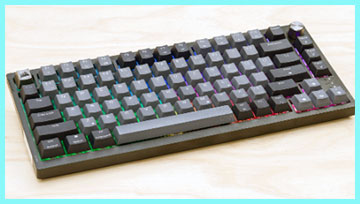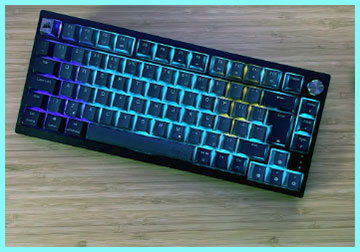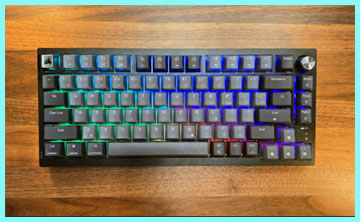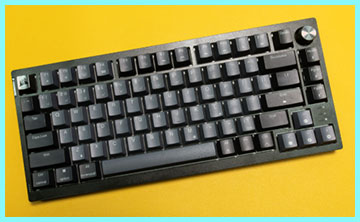For years, I’ve had a complicated relationship with Corsair keyboards. I respected their performance, but I hated their “gamer” feel. They were loud, rattly, and locked into an ecosystem that ignored the entire custom keyboard revolution.
So, when Corsair announced the K65 Plus Wireless, I was skeptical. But if you are like me—someone who craves the feel of a custom, hand-lubed, “thocky” keyboard but wants the convenience and lag-free wireless performance of a major gaming brand—my main intent is to tell you that this is the keyboard you should buy. This is Corsair’s redemption.
My Experience With The Corsair K65 Plus Wireless
My journey with mechanical keyboards has been a long one. My desk is a graveyard of old boards, including a classic Corsair K70 with Cherry MX Reds. I loved it for gaming, but typing on it was an ordeal. It was loud, scratchy, and the spacebar had a rattle that I could hear through my headphones. I eventually moved on, building my own keyboards with hand-lubed switches and foam inserts, chasing that perfect, muted, “thocky” sound. It’s an expensive and time-consuming hobby.

So, when I unboxed the K65 Plus Wireless, I was fully prepared to be disappointed. The first thing I noticed was the weight. This is not a hollow, plastic-feeling board; it’s a dense, solid brick. It has a real “heft” that screams “premium.” It doesn’t slide around my desk.
The layout is the 75% “Goldilocks” form factor. It’s compact and saves me a ton of mouse room, but I still get my F-keys, my arrow keys, and a dedicated ‘Delete’ key. As someone who splits time 50/50 between gaming and productivity, this layout is non-negotiable.
I plugged in the Slipstream wireless dongle, and it connected instantly. Then came the moment of truth. I put my hands on the keys. The keycaps weren’t the cheap, oily ABS plastic I was used to; they were a finely textured, durable PBT. Then, I typed my first sentence.
I had to stop and process what I was hearing. Or rather, what I wasn’t hearing. There was no metallic “PING.” There was no high-pitched “CLACK.” There was no scratchy, sandy sound. Instead, I got a deep, muted, smooth sound. It was the sound I had spent hours chasing with my custom builds.
Corsair finally did it. The K65 Plus is hot-swappable, but the real magic is that you don’t need to swap anything. It comes with their new Corsair MLX Red linear switches, and they are factory-lubed. This, combined with two layers of internal sound-dampening foam, creates an out-of-the-box experience that is just chef’s kiss. The spacebar and Shift keys—the classic weak points on every pre-built board—are shockingly quiet and stable.
The tri-mode connectivity is the other feature that has completely won me over. My setup is complex. I have my gaming PC (wired to my monitors) and my work laptop. With the K65 Plus, I use the Slipstream dongle for zero-lag gaming on my PC. When I need to switch to my job, I just press Fn + [Bluetooth key], and I’m instantly connected to my laptop. The 266-hour battery life (with RGB off) is not a joke; I’ve been using it for weeks and haven’t charged it once.
The multi-function dial is the cherry on top. By default, it’s a metal, clicky volume roller, which I love. But using the (admittedly bloated) iCUE software, I can set it to scroll through web pages, zoom in on a photo, or even switch applications.
This keyboard isn’t just “good for a Corsair board.” It’s an outstanding keyboard, period. It’s the first product from a major “gamer” brand that truly feels and sounds like it was made by enthusiasts, for everyone.
Read More: Comparison Of Das Keyboard And Keychron
Pros Of The Corsair K65 Plus Wireless
- That “Custom” Sound and Feel, Out of the Box: This is the #1 reason to buy this board. The typing experience is sublime. This is achieved through a “holy trinity” of features that enthusiasts usually have to build themselves. First, the Corsair MLX Red linear switches are fantastic. They are buttery smooth, fast for gaming, and have a very satisfying, quiet sound. Second, they come factory-lubed from Corsair. This eliminates the “scratchy” or “sandy” feeling that plagues 99% of pre-built mechanical keyboards. Third, Corsair has installed two layers of internal sound-dampening foam. One layer is between the metal plate and the circuit board (PCB), and another is in the bottom of the case. This combination completely eliminates the hollow, metallic “ping” and “rattle” you get from other boards, leaving only a deep, muted, satisfying “thock.”
- Hot-Swappable PCB for Endless Customization: This is a massive feature for a mainstream brand like Corsair. The switches are great, but what if you get bored in a year? Or what if you’re a “tactile” person who prefers a “bump” (like a brown switch)? On old Corsair boards, you were stuck. On the K65 Plus, you just use the included tool to pull the old switches out and push new ones in. No soldering, no technical skill required. It supports 5-pin switches, meaning it’s compatible with 99% of the custom switches on the market. This gives the keyboard an infinite lifespan and makes it the perfect gateway into the custom-keyboard hobby.
- Flawless Tri-Mode Connectivity and Battery Life: This board is the king of a clean desk. The 2.4Ghz Slipstream wireless is tournament-grade. It is absolutely “zero-lag” and just as fast and reliable as a wired connection for competitive gaming. Then, you have multi-device Bluetooth. I have it paired to my work laptop and my iPad. I can seamlessly swap between all three of my devices with a simple key combination. And the battery life is just absurd. With the RGB off, Corsair claims 266 hours. I can confirm that I’ve been using it for weeks on a single charge. This is a true, wire-free workhorse.
- Premium, Durable Components: Corsair didn’t cut corners where it counts. The keycaps are double-shot PBT, not the cheap, flimsy ABS plastic that all my old “gamer” keyboards had. This means the keycaps have a slightly textured, premium feel, and they will never get that gross, shiny, “oily” look after a few months. The letters (legends) are also part of the keycap itself, so they will never fade or wear off. The multi-function dial is solid metal, with a satisfying, tactile “click” when you turn it, which just feels expensive and durable.
- The Perfect 75% “Goldilocks” Layout: I am a 75% layout convert, and this board is the perfect execution of it. It’s incredibly compact, giving me a huge amount of extra desk space for my mouse, which is great for low-sensitivity FPS gaming. But unlike a 60% or 65% board, I don’t have to sacrifice my Function row (F1-F12), my arrow keys, or essential navigation keys like ‘Delete,’ ‘Page Up,’ and ‘Page Down.’ It’s the perfect balance of “compact” for gaming and “functional” for productivity. I can’t live without my arrow keys, and this layout delivers.
Cons Of The Corsair K65 Plus Wireless

- The Corsair iCUE Software Experience: (Sub-heading: Powerful, But Infamously Bloated)
- The Good: iCUE is an incredibly powerful, all-in-one software suite. If you, like me, already have a Corsair mouse, AIO cooler, and case fans, it’s a huge pro. You can sync your entire desk’s RGB with one click. You can re-map any key, create incredibly complex macros, and customize the multi-function dial to do anything (like scroll, zoom, or switch apps).
- The Bad: It’s a beast. iCUE is notoriously a “resource hog,” meaning it can use a noticeable amount of your PC’s background processing power. More importantly, it is not the simple, lightweight, community-driven QMK/VIA software that the enthusiast world uses. For a simple task like remapping a single key, iCUE can feel bloated and over-complicated. The board needs iCUE running in the background to unlock its most complex RGB and dial-customization features.
- The Stabilizers Are Good, Not “Perfect”: (Sub-heading: The Last 10% of the Custom Feel)
- The Rattle is Still (Barely) There: Corsair did an amazing job on the stabilizers for the price. They are pre-lubed, and they are 90% of the way to perfection. However, if I put my ear to the board in a quiet room, my spacebar and backspace key still have a tiny, tiny bit of “tick” and “rattle.”
- Why it Matters: A hand-built custom board would use tuned, screw-in stabilizers (like Durocks or TX APs) that are perfectly silent. This is the one, tiny detail that reminds you this is a mass-produced board. Most users will never, ever notice this. But if you’re a “sound-test” perfectionist like me, you’ll hear it, and you’ll want to mod it (which I’ll explain in the tips).
- The Keycaps Are PBT, But They’re Thin: (Sub-heading: A Nitpick on “Thock”)
- Material vs. Thickness: I’ll praise the PBT material all day. It’s durable and feels great. However, these are not the super-thick, 1.5mm-wall PBT keycaps that you get in an expensive, $100+ “GMK” or “Drop” keycap set.
- The Impact on Sound: The thickness of a keycap has a huge impact on the sound profile. These thinner keycaps create a slightly higher-pitched sound. The board is “thocky,” but with a set of really thick-wall PBTs, the sound would be even deeper and more muted. This was clearly a cost-saving measure to hit their price point, and it’s the first thing I’d consider upgrading.
- No Included Wrist Rest: (Sub-heading: An Ergonomic Omission)
- The Price Point: This keyboard is not cheap. It’s a premium, mid-range product. For the price, not including a wrist rest feels like a corner-cut.
- The Ergonomics: The board has a medium-high front-edge profile, and it does not have flip-out feet (it’s at a fixed angle). After a long, multi-hour typing session, my wrists definitely feel that upward angle. I need a wrist rest for this board. Corsair is, of course, very happy to sell you one of their premium magnetic wrist rests, but I really feel it should have been included in the box.
Maintenance Tips For The Corsair K65 Plus Wireless

- The 10-Minute Stabilizer Mod: (Sub-heading: How to Get That “Endgame” Sound)
- This is my #1 tip. That tiny “tick” I mentioned in the cons? You can eliminate it for free, in 10 minutes. This is the “Band-Aid Mod” or “Tape Mod.”
- The Method: Use the included keycap puller to gently remove the spacebar, backspace, and Enter keys. You’ll see the stabilizers (the wire and two plastic “stems”).
- The Fix: Take a small piece of a fabric Band-Aid (the fabric kind, not the plastic kind) or a small piece of painter’s tape. Cut two tiny squares.
- Apply: Use tweezers to place these tiny tape squares on the keyboard’s circuit board (PCB) right under where the two stabilizer stems would land.
- Re-assemble: Press the stabilizer stems back into their housings and put the keycap back on.
- The Result: The soft tape cushions the “bottom-out” of the stabilizer, completely eliminating that plasticky “tick.” Your board will sound 2x as expensive. It’s the best mod you can possibly do.
- Mastering the “No Software” Onboard Controls: (Sub-heading: How to Ditch iCUE on the Go)
- You Don’t Need iCUE: If you’re using your K65 Plus on a work laptop where you can’t install iCUE, you’re not helpless. You can control almost everything from the board.
- Connectivity: Fn + B/N/M are your three Bluetooth profiles. Fn + G is your Slipstream wireless. Fn + V is USB wired mode.
- RGB Control: The multi-function dial is your best friend. Hold Fn + click the dial (the button under the knob). This will “unlock” the dial’s secondary mode. Now, turning the dial will cycle through 11 different pre-set RGB effects (like rainbow, rain, watercolor, etc.). Clicking the dial will change the direction of the effect. Hold Fn + click again to go back to volume control.
- Media Keys: Fn + F7/F8 are your media track controls, and Fn + F9 is your play/pause.
- Hot-Swapping Switches Safely (A Beginner’s Guide): (Sub-heading: Don’t Bend Your Pins!)
- The Tools: Your box comes with a 2-in-1 keycap and switch puller. The “wire” side is for keycaps. The “two-pronged” side is for switches.
- The Removal: Pull the keycap off first. Then, use the switch puller to “pinch” the switch on its top and bottom tabs. Squeeze the puller, and pull straight up while wiggling the switch gently back and forth. It should pop right out.
- The Installation: This is the critical part. Look at your new switch. It has 5 metal pins. Make sure they are all PERFECTLY STRAIGHT. If even one is slightly bent, do not try to force it. Gently bend it back with tweezers.
- The “Click”: Line up the pins with the 5 holes in the socket. Press the switch straight down. You should feel a soft, satisfying click as it seats. If you feel any resistance, STOP, pull it out, and check your pins again. You are about to bend a pin.
- Cleaning Your PBT Keycaps (The Right Way): (Sub-heading: How to Restore That “New” Feel)
- The Problem: PBT is great, but it’s not “magic.” After a few months, the oils from your fingers will still build up on that fine texture.
- The Fix: Once every six months, pull all your keycaps off (take a picture of the layout first!).
- The Bath: Get a bowl of warm, soapy water (a few drops of regular dish soap is perfect). Do not use hot/boiling water or harsh chemicals.
- The Soak: Drop all the keycaps in the bowl and let them soak for about an hour. You can gently rub any extra-grimy ones (like your WASD keys) with your fingers.
- The Rinse and Dry: Rinse them thoroughly in cool water. Then, lay them all out on a towel, stem-side-down, and let them air-dry completely overnight. Do not put them back on when they are still damp. This is the best way to get that brand-new, textured feel back.
- Maximize Your Battery Life (The Obvious Tip): (Sub-heading: The RGB is the Enemy of Battery Life)
- 266 Hours vs. 30 Hours: That 266-hour battery life claim? That is with the RGB lighting 100% OFF. With the RGB on at a reasonable brightness, you’re looking at a more realistic 30-40 hours of use.
- My Routine: This is still great battery life! But if you’re traveling or just want to go a full month without charging, hold Fn + click the dial and cycle through until you hit the “all-off” lighting preset. You’ll go from charging it weekly to charging it “whenever you remember.”
Comparison With Other Brands

The K65 Plus Wireless isn’t just competing with other Corsair boards; it’s competing with the best 75% boards on the market. Here’s how it stacks up for me.
Corsair K65 Plus Wireless vs. The Asus ROG Azoth
- The Direct Competitor: The Asus ROG Azoth is this board’s most direct rival. It’s also a 75%, hot-swappable, foam-dampened wireless board from a major “gamer” brand. Its big “wow” features are the OLED screen in the corner and the fact that it comes with a lube kit in the box (which is a bit of a gimmick).
- My Verdict: The Azoth is a fantastic keyboard, but it is significantly more expensive than the K65 Plus. The OLED screen is a cool party trick, but in my daily use, the K65 Plus’s metal, clicky multi-function dial is far more practical and useful than a tiny screen. The K65 Plus delivers 95% of the Azoth’s premium typing experience and feel for a much, much better price.
Corsair K65 Plus Wireless vs. The Keychron Q1 Pro
- The Enthusiast’s Choice: The Keychron Q1 Pro is the board that the K65 Plus is clearly trying to emulate. It’s the “OG” of the mainstream custom world. Its biggest “pro” is its all-aluminum, gasket-mounted case. It feels even more premium and heavy than the K65. It also runs on the open-source QMK/VIA software, which enthusiasts love.
- My Verdict: The Q1 Pro feels heavier and more “custom” because of that aluminum case. However, its Bluetooth can be finicky, and it has no high-speed 2.4Ghz wireless dongle. This makes it a worse choice for fast-paced, competitive gaming. The K65 Plus wins, hands-down, on wireless performance (Slipstream) and software unification (iCUE), making it the better, more reliable “do-it-all” board for both gaming and work.
Corsair K65 Plus Wireless vs. The SteelSeries Apex Pro Mini Wireless
- The Switch Innovator: The SteelSeries Apex Pro Mini is a smaller 60% board, but its main feature is the OmniPoint switches. These are analog switches that let you customize the actuation point (how far you press the key to register) in the software. You can make it super-sensitive for gaming or deep for typing.
- My Verdict: The Apex Pro’s switches are amazing technology, but the 60% layout is a massive compromise. You lose your arrow keys, your F-row, and all your navigation keys. It’s a “gaming-only” board. The K65 Plus’s 75% layout is infinitely more practical for anyone who does anything besides just gaming. The K65’s hot-swap feature also gives it more long-term versatility than the proprietary (and non-swappable) OmniPoint switches.
Also Read: Comparison Of HP OMEN Vs. Lenovo Legion Desktop
Frequently Asked Questions (FAQ)
It’s simple. For the fastest, lag-free connection (for gaming), plug the included Slipstream USB dongle into your PC. For Bluetooth, press and hold Fn + B, N, or M until the light blinks, then find it in your device’s Bluetooth settings. Or just plug in the USB-C cable for a wired connection.
The pros are its fantastic “thocky” sound, hot-swappable switches, premium PBT keycaps, and amazing tri-mode connectivity (Slipstream, Bluetooth, USB). The main cons are the bloated iCUE software (compared to VIA/QMK) and stabilizers that are good, but not “enthusiast-perfect.”
You can do it two ways. The easiest way is onboard: Hold Fn + click the multi-function dial. Now, turning the dial will cycle through 11 different built-in RGB effects. For per-key, custom lighting, you need to use the Corsair iCUE software on your computer.
Its main features are: a 75% layout, hot-swappable switch sockets (5-pin), pre-lubed Corsair MLX Red linear switches, tri-mode wireless (Slipstream, Bluetooth, Wired), a multi-function rotary dial, and two layers of internal sound-dampening foam.
Conclusion
For the first time in my life, I can recommend a Corsair keyboard to everyone, not just “gamers.” This is the board where Corsair finally stopped being stubborn and started listening. It gives you 90% of the custom, hand-built keyboard experience with none of the hassle. It has the sound, the feel, and the enthusiast features (hot-swap, PBT, foam) while retaining the “pro-gamer” features (Slipstream, iCUE). It’s the perfect hybrid. If you’re ready to “graduate” from your old, rattly keyboard to something that feels truly premium, this is the one you should buy.
